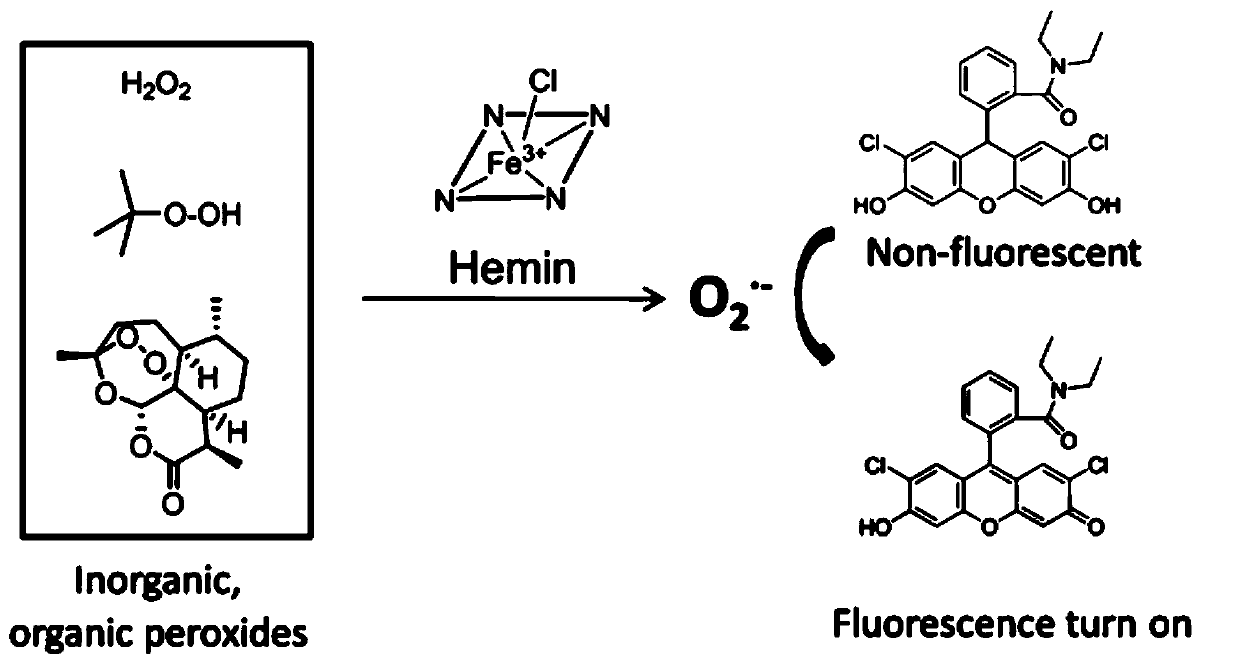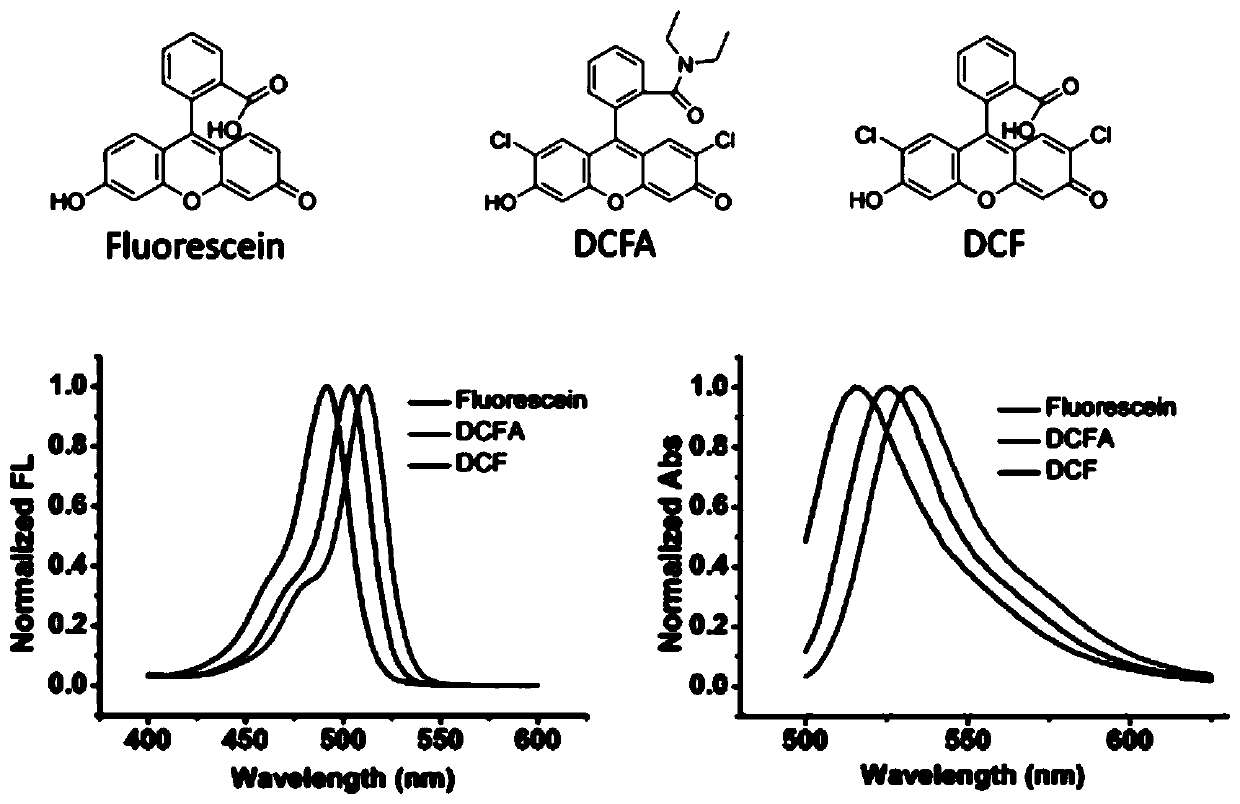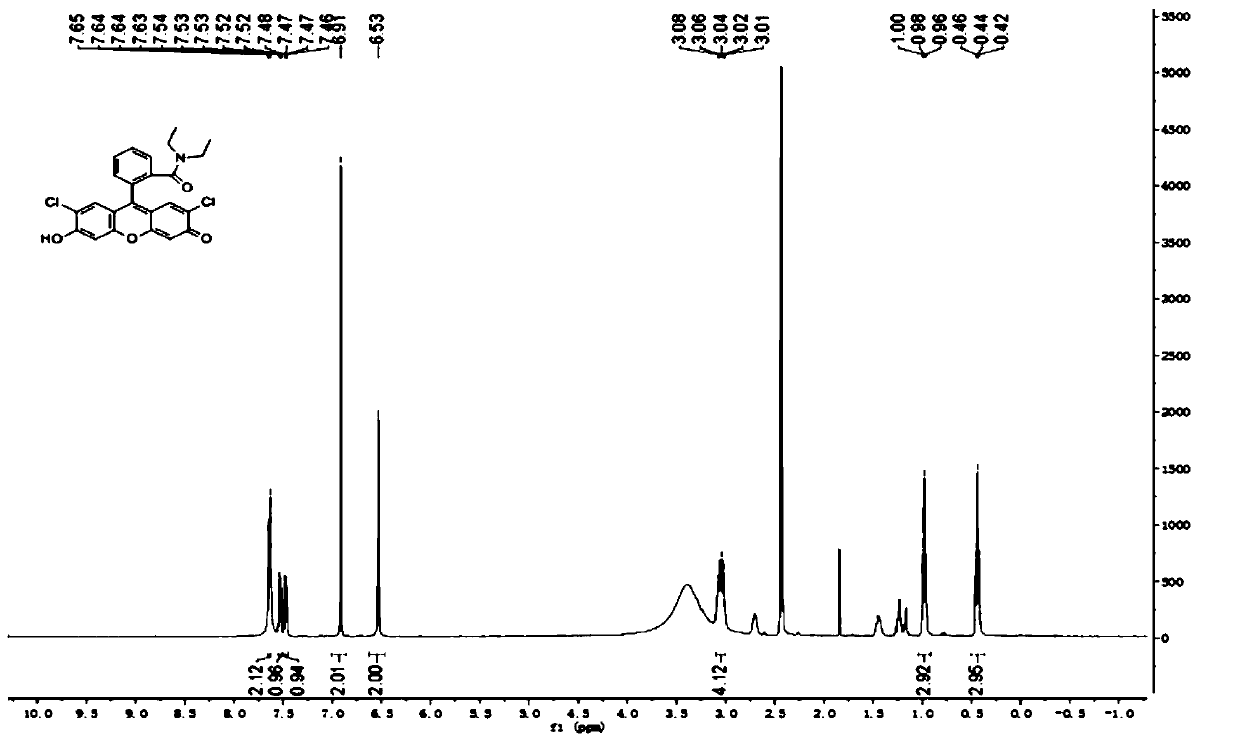Hydrogenated dichlorofluorescein diacetamide derivative as well as preparation method and application thereof
An amide derivative, dichlorofluorescein technology, applied in the field of heme detection, can solve the problem of few reports on heme fluorescence measurement
- Summary
- Abstract
- Description
- Claims
- Application Information
AI Technical Summary
Problems solved by technology
Method used
Image
Examples
Embodiment 1
[0053] Design and synthesis of embodiment 1 fluorescent reporter molecule
[0054] (1) Design of Hydrogenated Dichlorofluorescein Diacetamide Derivatives
[0055] 2',7'-dichlorofluorescein (DCF) was selected as the dye to prepare the fluorescent reporter molecule, which is a cheap and commercially available dye with green fluorescence suitable for naked-eye observation. In a preliminary study, it was found that the maximum intensity of the spectrum was normalized by setting the molecular concentration of fluorescein, DCF and amide derivative intermediate (DCFA) at 20 μM in BR buffer (pH 12) with excitation at 475 nm is 1, its UV-Vis spectrum and fluorescence spectrum are as follows figure 2 shown. Depend on figure 2 It can be seen that the acylation modification of DCF with diethylamine can lead to a significant red shift in its fluorescence spectrum, with a peak at around 530 nm. Therefore, the emission of DCFA is closer to the eye-sensitive yellow-green (550nm), so the...
Embodiment 2
[0061] The optimization of embodiment 2 detection conditions
[0062] (1) Optimization of detection condition pH value
[0063] Firstly, the pH conditions of the reaction were optimized. DCFHA and corresponding peroxides were prepared in BR buffer (0.04M H 3 BO 3 , 0.04MH 3 PO 4 and 0.04M CH 3 COOH, 1.0MmEDTA, NaOH), and then the reaction was monitored by fluorescence kinetics, and the fluorescence was recorded at intervals of 10 seconds with a microplate reader, and the excitation wavelength was 475nm. All experiments were performed with 50 μM DCFHA and 1 μM heme, and 100 μM H2 o 2 , TBHP at 200 μM and ART at 5 μM. The effect of pH on the detection of hemoglobin is as follows: Figure 6 As shown, it can be seen that increasing the pH from 9 to 12 has no effect on DCFHA / H 2 o 2 The reaction rate of the DCFHA / TBHP system has a great influence, therefore, the optional range of pH is 9-12. And increasing the pH can improve the response of the DCFHA / ART detection system...
Embodiment 3
[0067] Embodiment 3 quantitative measurement of hemoglobin
[0068] (1) Use DCFHA / H 2 o 2 System for quantitative hemoglobin measurement
[0069] DCFHA(50μM) / H when the detected hemoglobin concentration is 0~2μM 2 o 2 (100μM) absorption spectrum and fluorescence spectrum of the solution, and the fluorescence intensity I 530 The titration curve obtained by plotting the hemoglobin concentration, all solutions are excited at 475nm, such as Figure 9 shown.
[0070] Depend on Figure 9 It can be seen that when hemoglobin is 0-20nM, I 530 There is an excellent linear relationship between and hemoglobin concentration. When the hemoglobin is between 0 and 0.1 μM, the fluorescence intensity I 530 The increase showed a clear concentration dependence. Compared with the control without heme, 0.1 μM heme can lead to I 530 Enhancement up to 150-fold; further increases in hemoglobin concentration, I 530 No significant increase. UV-Vis spectra showed similar trends as fluorescen...
PUM
 Login to View More
Login to View More Abstract
Description
Claims
Application Information
 Login to View More
Login to View More - R&D
- Intellectual Property
- Life Sciences
- Materials
- Tech Scout
- Unparalleled Data Quality
- Higher Quality Content
- 60% Fewer Hallucinations
Browse by: Latest US Patents, China's latest patents, Technical Efficacy Thesaurus, Application Domain, Technology Topic, Popular Technical Reports.
© 2025 PatSnap. All rights reserved.Legal|Privacy policy|Modern Slavery Act Transparency Statement|Sitemap|About US| Contact US: help@patsnap.com



